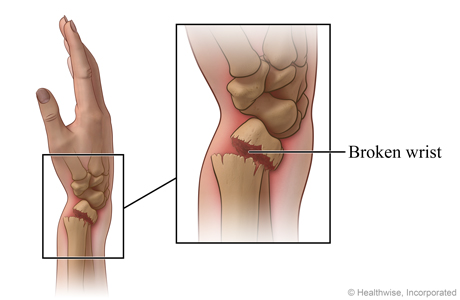
Overview
A Colles (say "CALL-us" or "CALL-eez") fracture is a specific type of broken wrist. In this type of fracture, the broken bone in the wrist tilts upward when the hand is palm down. The break may happen when you throw out a hand to protect yourself in a fall. Your treatment depends on how bad the break is.
Your doctor may have put your wrist in a cast or splint. This will help keep your wrist stable and keep the bone in the right position. Sometimes surgery is needed to help keep the bone in position for good healing.
It will take several weeks to a few months for your wrist to heal. You can help it heal with care at home. You heal best when you take good care of yourself. Eat a variety of healthy foods, and don't smoke.
You may have had a sedative to help you relax. You may be unsteady after having sedation. It can take a few hours for the medicine's effects to wear off. Common side effects include nausea, vomiting, and feeling sleepy or tired.
The doctor has checked you carefully, but problems can develop later. If you notice any problems or new symptoms, get medical treatment right away.
Follow-up care is a key part of your treatment and safety. Be sure to make and go to all appointments, and call your doctor if you are having problems. It's also a good idea to know your test results and keep a list of the medicines you take.
How can you care for yourself at home?
- If your doctor gave you a sedative:
- For 24 hours, don't do anything that requires attention to detail, such as going to work, making important decisions, or signing any legal documents. It takes time for the medicine's effects to completely wear off.
- For your safety, do not drive or operate any machinery that could be dangerous. Wait until the medicine wears off. You need to be able to think clearly and react easily.
- Be safe with medicines. Take pain medicines exactly as directed.
- If the doctor gave you a prescription medicine for pain, take it as prescribed.
- If you are not taking a prescription pain medicine, ask your doctor if you can take an over-the-counter medicine.
- Put ice or a cold pack on your wrist for 10 to 20 minutes at a time. Try to do this every 1 to 2 hours for the next 3 days (when you are awake). Put a thin cloth between the ice and your cast or splint. Keep your cast or splint dry.
- Follow the splint or cast care instructions that your doctor gives you. If you have a splint, do not take it off unless your doctor tells you to. Be careful not to put the splint on too tight.
- Prop up your arm on pillows when you sit or lie down in the first few days after the injury. Keep your wrist higher than the level of your heart. This will help reduce swelling.
- Move your fingers often to reduce swelling and stiffness. But don't use that hand to grab or carry anything.
- Follow instructions for exercises to keep your arm strong.
When should you call for help?
Call 911 anytime you think you may need emergency care. For example, call if:
- You have trouble breathing.
- You passed out (lost consciousness).
- You are very sleepy, and you have trouble waking up.
Call your doctor now or seek immediate medical care if:
- You have new or worse nausea or vomiting.
- You have new or worse pain.
- Your hand or fingers are cool or pale or change color.
- Your cast or splint feels too tight.
- You have tingling, weakness, or numbness in your hand or fingers.
Watch closely for changes in your health, and be sure to contact your doctor if:
- You have problems with your cast or splint.
- You do not get better as expected.
Where can you learn more?
Go to http://www.healthwise.net/patientEd
Enter F496 in the search box to learn more about "Colles Fracture: Care Instructions".
Current as of: July 24, 2025
Author: Ignite Healthwise, LLC Staff
Clinical Review Board
All Ignite Healthwise, LLC education is reviewed by a team that includes physicians, nurses, advanced practitioners, registered dieticians, and other healthcare professionals.

